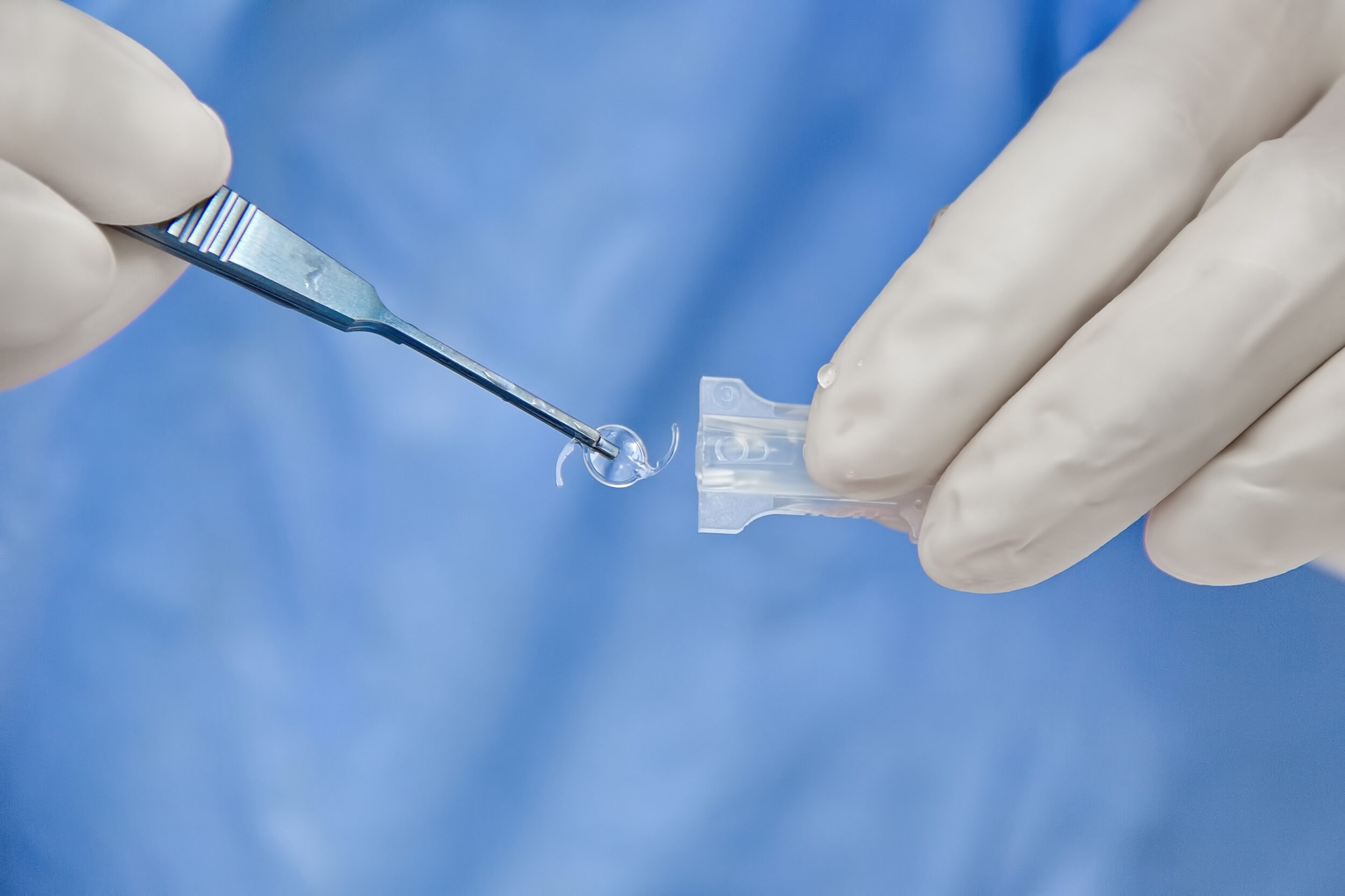Intraocular lens (IOL) implantation is a surgical procedure that helps patients regain their visual acuity after being diagnosed with a variety of visual disturbances, such as glaucoma, refractory errors, and cataracts.
This revolutionary ophthalmology service is a multi-step procedure that involves the replacement of your eye's natural lens with an artificial one. This, in turn, can restore your vision and also improve the quality of your life.
Dr. Murrell, who is double-certified by The American Board of Ophthalmology and The American Society of Oculoplastic and Reconstructive Surgeons, specializes in IOL surgery, helping patients restore visual acuity. With the utmost precision, he utilizes cutting-edge technology to deliver exceptional results.
How Is Intraocular Surgery Performed?
IOL surgery is usually performed to treat patients diagnosed with cataracts. Most cataracts occur because of changes that happen naturally as you get older. As the cataract progresses, your vision can become cloudy and may eventually lead to blurred vision.

During intraocular lens surgery, a small incision in the cornea and the clouded lens is gently removed. The IOL is then inserted to replace your natural lens that was removed.
Types Of Intraocular Lens
Four different types of intraocular lenses are used for lens replacement.
Monofocal IOL
Monofocal lenses are the most commonly used IOL in lens replacement surgery. Monofocals can help patients have clearer vision at one single point, which is typically at distance vision. This means that after the procedure, you may be able to see into the distance but will still need glasses to see things close to you.
Toric IOL
Toric lenses correct astigmatism, a visual condition that is characterized by an irregularly shaped cornea. Patients diagnosed with astigmatism usually have blurred or distorted vision at certain distances. Because toric lenses have different powers at varying meridians, it allows for greater correction in visual acuity.
Multifocal IOL
Multifocal lenses are unique because they offer a wide range of focal points, which improves your vision acuity at different distances. Multiple lenses are designed to reduce or completely eliminate the need for glasses, especially when it comes to reading glasses. Since multifocal lenses incorporate different zones on the lens surface, most patients see an improvement in both near and distance vision paths.
LAL (Light Adjustable Lens)
Corrects vision at one focal point, usually distance in the dominant eye and distance/intermediate in the non-dominant eye. This IOL can be adjusted after surgery to customize and maximize your vision.
Premium Lens Options – Additional Cost For These Lenses Not Covered By Insurance
Toric Lens
(The monofocal IOL with astigmatism)
Almost every eye has some astigmatism. This occurs when the clear cornea in the front of the eye is irregularly shaped. Those patients with very minimal or mild astigmatism do not require this IOL. However, those patients who have moderate to severe astigmatism may choose this IOL so they can see better at the focal point they decide (usually distance). This lens corrects vision, including astigmatism, at ONE focal point. This can be at a distance, intermediate, or near.
- 25% of patients may still need distance glasses
- 100% of patients will need reading glasses
- Remember, this is a premium IOL with an out-of-pocket cost to you.
PanOptix Lens
(Distance, Intermediate, and Near IOL)
This IOL gives vision at all three focal points: Distance, Intermediate (computer/dashboard), and Near.
- 20% of the patients may still need glasses at a distance, intermediately or near, while 80% won't need glasses.
- This IOL design may give glare or halos of light at night (in my experience, less than 5%). While many patients have this, very few are bothered by it.
- This IOL is available in a Toric option if the patient has moderate to severe astigmatism.
- Remember, this is a premium IOL with an out-of-pocket cost to you.
Can Each Eye Have a Different Multifocal IOL?

It's possible to have a different IOL in each eye. Mixing IOLs may be ideal if you want to improve distance vision in one eye and near vision in the other, for example. We make this choice very carefully with an in-depth discussion about your desired outcome, needs, and preferences.
How Can I Prepare for the Intraocular Lens Procedure?
There usually isn't much to do to prepare for cataract removal surgery. During your consultation, it is important to inform the doctor of any medications you're taking. Some may need to be stopped or altered to prevent surgical risks. You'll receive pre-surgical instructions before your procedure. Please review them well in advance and contact our office if you have any questions. You may also receive a prescription for antibiotics to begin taking before surgery. If this is the case, it is important to use them as directed.
How Do IOL Implants Work?
The IOL is made with precise power based on the position of the lens, the curvature of the cornea, and the length of the eye. Each of these measurements is taken prior to surgery and may be checked again during surgery when adjustments can be made. Your intraocular lens is designed to work like your natural lens, prescription eyeglasses, or contacts. As light passes through the front of the eye, it bends based on the power of the IOL. This focuses rays of light to land accurately on the retina at the back of the eye. The accuracy of the rays of light supports crisp, clear vision at multiple distances.
How Do You Know If You Need an Intraocular Lens?
Every person who undergoes cataract removal surgery needs an intraocular lens. This is because, during cataract removal surgery, the entire natural lens of the eye is extracted. Intraocular lens technology can also be used to improve vision that is not affected by cataracts. This is referred to as refractive lens exchange surgery. It is sometimes considered for adults who are not good candidates for LASIK.
How is Implantation Performed?
Lens implantation is the final aspect of cataract-removal surgery. After the clouded lens is removed during the procedure, the new lens, the IOL, is folded and inserted into the same capsule that held the natural lens. It is secured in the capsule, which will naturally heal around the IOL over the course of several days.
How Long Do Multifocal Lenses Last?
Multifocal IOLs are designed to last many years, if not indefinitely. The new lens is positioned just like the one that has been removed and does not require any specific maintenance. You shouldn't even be aware that you have it, other than that you can see better than you have in a long time.
Are There Any Risks or Complications Associated With IOL Implantation?
Intraocular lens implantation is a safe and common procedure. However, like any surgery, there are potential risks and complications:
- Infection: Though rare, an infection inside the eye can occur. This requires prompt treatment with antibiotics.
- Inflammation: Mild inflammation is common after surgery. You can manage it with prescribed eye drops. Persistent or severe inflammation is less common.
- Posterior Capsule Opacification (PCO): The thin membrane holding the IOL may become cloudy. This is treatable with a quick and painless YAG laser capsulotomy.
- Dislocation of the IOL: The artificial lens may shift out of position and cause blurry vision. Repositioning or replacing the IOL may be necessary.
Dr. Murrell is an experienced ophthalmologist. He uses advanced techniques to reduce risks and help patients achieve their desired outcomes.
How Long Does It Take To Recover From IOL Surgery?
Recovery from IOL surgery is usually quick. Here's a general timeline:
Immediate Post-Surgery (First 24 Hours)
- You may experience mild discomfort, light sensitivity, or a gritty sensation.
- Vision may appear blurry or cloudy as your eye starts healing and adjusting.
- Resting and avoiding strenuous activities are key during this period.
First Week
Most patients notice vision improvements within a few days.
Dr. Murrell may recommend:
- Using prescribed eye drops (antibiotic and anti-inflammatory) to prevent infection and reduce inflammation.
- Avoiding activities like swimming, heavy lifting, and bending over to prevent pressure on the eye.
- Wearing an eye shield when sleeping.
Two to Four Weeks
- Healing continues, and your vision stabilizes further.
- Your doctor may clear you for light activities and work, depending on your occupation.
- Follow-up appointments will ensure your recovery is progressing as expected.
One to Three Months
At this point, complete healing is usually achieved. Your final vision outcome will likely become clear as well. You can correct residual refractive errors with glasses or contact lenses, if necessary.
Keep in mind that if you chose a premium IOL (like multifocal or toric lenses), your brain will continue to adjust to the new vision.
Can I Treat Both Eyes at the Same Time With IOLs?
In most cases, both eyes are not treated at the same time with intraocular lens implantation. Instead, the procedure is performed on one eye at a time. A short interval – usually one to two weeks – also occurs between surgeries.
This approach offers several benefits, including:
- Easier Monitoring: Treating one eye first allows your surgeon to assess its healing and vision improvement. If you need adjustments, they can be factored in when treating the second eye.
- Easier Risk Management: Performing the surgeries separately minimizes the risk of complications affecting both eyes at once, such as infection or inflammation.
- Increased Patient Comfort: Treating one eye at a time allows you to use the other eye for daily activities during recovery.
Why Choose Walter John Murrell, MD?
Choose Walter John Murrell, MD, for his unmatched expertise in cataracts and oculoplastics. As a board-certified ophthalmologist, Dr. Murrell holds dual certifications from The American Board of Ophthalmology and The American Society of Oculoplastic and Reconstructive Surgeons (ASOPRS).
Dr. Murrell's dedication to cutting-edge care is evident in his ongoing education. He hones his skills by attending the ASOPRS Conference twice yearly and the AAO Conference each year. With a commitment to delivering superior care, he combines precise techniques with the latest technological advancements.
Schedule a Consultation Today
Modern cataract surgery and a range of IOL options provide today's cataract patients with many choices. Learning as much as you can about these choices prior to your evaluation will help you ensure that you get the type of vision requirements that you desire.
To learn more, schedule a consultation at our Amarillo, TX, office with Dr. Murrell by calling (806) 351-1177. You can also send us a message.
